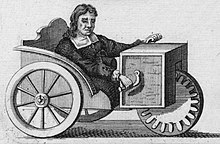Articulated steering
Articulated steering is the name of a form of vehicle steering . It assumes that the two- or multi-axle vehicle consists of at least two parts that are connected by a joint . The change of direction takes place by horizontally pivoting (or "buckling") the vehicle parts together with the wheel sets attached to them . The wheel axles , which are rigidly mounted in the sub-bodies, result in a more or less curved driving course depending on the steering angle. This type of steering is often seen in self-propelled construction and work machines that require good maneuverability in a small space, e.g. B. with woodwork in the forest. Vehicles with this design are often referred to as articulated steering . The connection between the front and rear end is usually made with double- adjusted tapered roller bearings .
One advantage is that there are no components in the lower areas of the vehicle that are at risk from contact with the ground or objects. For this, it is accepted that all control, hydraulic and electrical cables and, in the case of all-wheel drive, also the drive shaft are routed flexibly through the articulated joint. Usually the vehicle torsion in the articulated joint is also compensated d. H. both axles are basically rigid and any twisting between the front and rear axles is absorbed by another joint attached to the articulation joint.
history
This form of steering was first mentioned in 1685, when the watchmaker Stephan Farfler from Altdorf near Nuremberg developed the technology for installation in a three-wheel wheelchair . In 1835 the English carriage builder William Bridges Adams adopted this form of steering for the construction of horse-drawn carriages. The disadvantages of the construction, the larger turning radius than swivel-axle wagons and the complicated separation of the car body, as well as expensive production, made use in automobiles and trucks rather unattractive.
Around 1940, joints were developed that also allowed additional movement around the transverse axis. This made the use of articulated steering for military vehicles and tractors (see articulated tractor ) possible. These joints result in small turning radii, the vehicles can maneuver on uneven terrain. Another advantage is that the front and rear wheels overlap the lanes, so that the rear wheels use the compacted track of the front wheels and thus the rolling resistance is drastically reduced. In wheel loaders and small excavators based on wheels, the articulated steering enables the shovel to pivot laterally. The simplification of maneuvering is also beneficial, since the steering geometry when driving forward is identical to that when driving backward.
See also
Individual evidence
- ↑ Detailed drawing of an articulated handlebar (page 5), accessed on December 3, 2010 ( memento of the original from January 17, 2016 in the Internet Archive ) Info: The archive link was inserted automatically and has not yet been checked. Please check the original and archive link according to the instructions and then remove this notice. (PDF; 1.4 MB)





